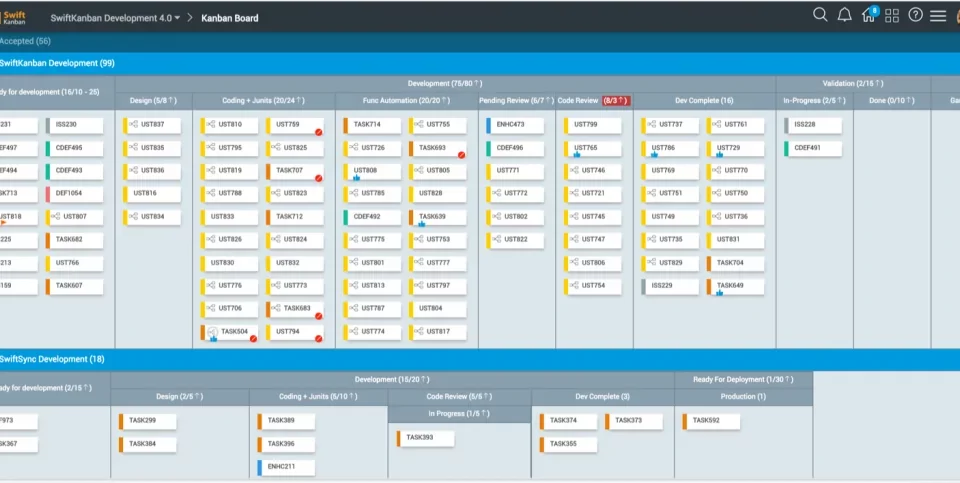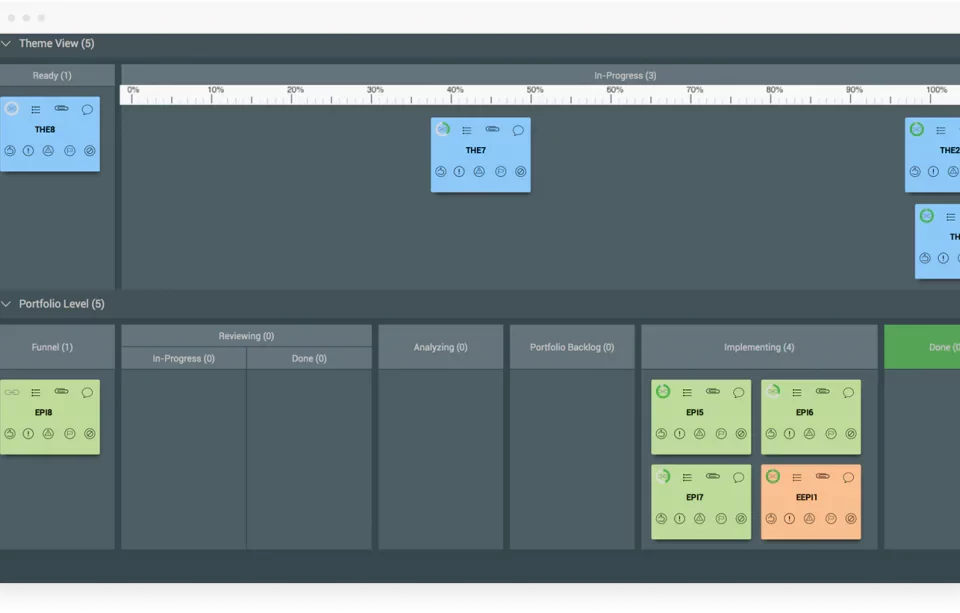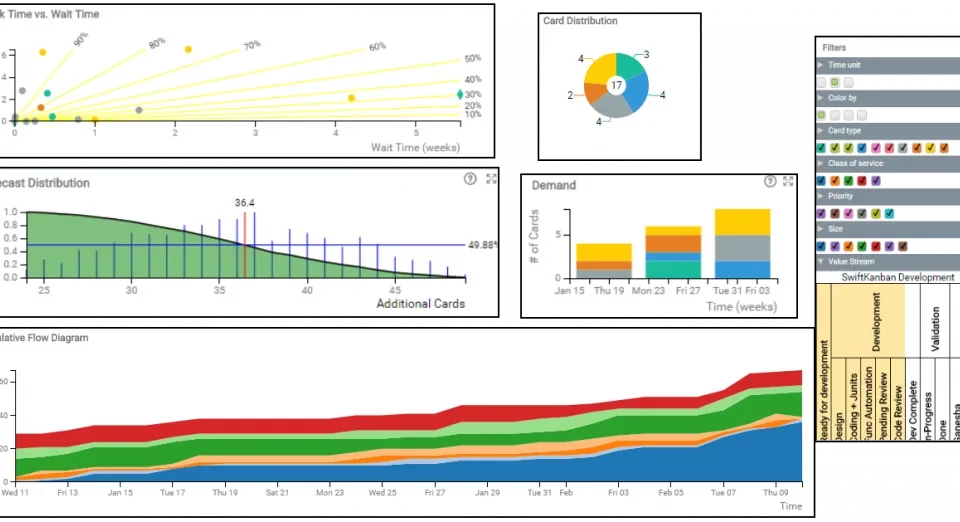- Filter by
- Categories
- Tags
- Authors
- Show all
- All
- Agile
- Agile ALM
- Agile Marketing
- Agile Metrics
- Agile Tool
- AI
- ALM
- ALM Tools
- Application Lifecycle Management
- Application Portfolio Management
- Artificial Intelligence
- Blogs
- Bytes
- Capacity Planning
- Collaboration
- Essential SAFe
- Everyday Kanban
- Hybrid Agile
- Kanban
- Kanban board
- Kanban cycles
- Kanban for Distributed Teams
- Kanban Tool
- Leadership
- Lean
- Lean ALM
- Lean Software Development
- Lean SSC
- Lean/ Kanban
- Management
- Modern Management
- News and Events
- Newsletter
- Portfolio Kanban
- Portfolio Management
- PPM
- Process Maturity
- Product Updates
- Product Webinars
- Project Management
- Remote Working
- Requirements Management
- SAFe
- Scaled Agile ALM
- SwiftEnterprise
- SwiftEnterprise Updates
- Uncategorized
- Upcoming Webinars
- Visual Management
- Visualization
- Webinars
- WIP
- All
- Account Reporting
- agile
- Agile 101
- Agile ALM
- Agile Management
- Agile Marketing
- Agile Metrics
- Agile Tool
- AgileIndia2015
- Agility
- AI
- ALM
- ALM Tools
- Application Lifecycle Management
- august swiftkanban
- Be Nimble
- Benefits of ALM
- Best
- Books
- Brochures
- Burndown Chart
- Business Benefits of ALM
- Business Management
- Capacity Planning
- Card Color
- Case Studies
- Change Management
- Checklists
- class of service CoS
- cognitive thinking
- Collaboration
- Collaborative Product Management
- continuous improvement
- Customer Satisfaction
- Cycle Time Analysis
- Cycle time settings
- Cycles
- DAD
- Developer Productivity
- DevOps
- Discovery Kanban
- Effort Tracking
- Elimination of waste
- Employee Engagement
- Employee Productivity
- Enterprise Kanban
- enterprise se
- Enterprise Services Planning
- Esp
- Essential SAFe 4.0
- Fixed-Duration Projects
- Fixed-Price Projects
- flowefficiency
- Getting things done
- Global Delivery Model
- Granular Kanban
- GTD
- Humanizing Work
- Hybrid Agile
- Importance of WIP Limits
- Infographics
- innovation
- Issue management
- IT
- IT Ops
- Kanban
- Kanban 101
- kanban app
- Kanban board
- kanban cadences
- kanban cards
- Kanban cycles
- Kanban for Business Analysis
- Kanban for Distributed Teams
- Kanban Hierarchy
- Kanban in Marketing
- Kanban in Procurement
- Kanban Portfolio Management
- kanban to-do Board
- Kanban Tool
- Kanban tools
- kanban update
- Kanban/ Agile Webinars
- kanbanflow
- Kanbantraining
- Leadership
- Lean
- Lean ALM
- Lean Procurement
- Lean Software Development
- Lean SSC
- Lean/ Kanban
- Lean/agile framework
- leankanban
- Leankanbanuniversity
- Learning
- LeSS
- LSSC11
- Management
- marketing management
- Modern Management
- MUDA
- Objectives
- Paired Programming
- Personal Kanban
- PI Planning
- PKFLOW
- Planning & Tracking
- PM 101
- Portfolio Kanban
- Portfolio Management
- PPM
- Process
- Process Maturity
- processes
- Procurement
- Product Management
- Product Owner
- Product Webinars
- Program Increment
- Project Portfolio Management
- Project Team Productivity
- Quantification
- Release Management
- Release Train Engineer
- Replenishment Meeting
- Reporting
- Requirements Management
- RoI of ALM Tools
- Root cause analysis
- SAFe
- Scaled Agile
- Scaled Agile ALM
- Scaled Agile Framework
- Scaling Agile
- Scrum
- Scrumban
- Software
- Software Estimation
- SwiftESP
- SwiftKanban
- SwiftKanban iOS app
- swiftkanban july
- swiftkanban june
- swiftkanban mobile app
- SwiftKanban Update
- Systems Thinking
- Task Lists
- Team Kanban
- Teams
- To-Do Board swiftkanban
- To-Do Lists
- Toyota Kata
- upstream Kanban
- user story
- Visual Management
- Visual Project Management
- Visualization
- Webinars
- Whitepapers
- WIP
- WIP limit
- wip limits kanban
- Work Breakdown
- XP
- All
- Muhammad Raza
- Anadi Misra
- Andrea Fryrear
- Repaka Anjana Likitha
- Anitej Rao
- Ashwin Swarup
- Ashwini Lalit
- Anshuman Singh
- Bhaskar S
- Bhavesh Siddamsettiwar
- Raghunath Basavanahalli
- Bash Sarmiento
- Burkhard Berger
- Carlos Schults
- Christina Sookram
- Christophe Achouiantz
- David Anderson
- Dave White
- Elizabeth Harrin
- Florian Boldt
- Team Infosec
- Joaquin Aceron
- Jim Benson
- Julia Wester
- Karan Gadani
- Kshipra Bhat
- Linsa Saji
- Mahesh Singh
- Manikandan R
- Marjan Venema
- Masa K Maeda
- Mike Burrows
- Navin Anand
- NimbleWork PR
- Nishanth Mittu
- Niveditha Reddy
- Natalia Manha
- Priyank Parekh
- Ram Subramanian
- Rumyana Dancheva
- Roman Shvydun
- Rupal Kaushik
- Siddharth Dutta
- Simli Saha
- Subhajit Sengupta
- Sudipta Lahiri
- Sunita Vyas
- Team ESG
- Zach Watson
March 19, 2018
Published by Christophe Achouiantz on March 19, 2018
Categories
In part 2 of this series, Christophe looks at the very Swedish phenomenon of Kanban going “man-cold”! As teams implement their early Kanban boards, they inevitably face the reality of the gap between what they are actually used to doing vs. what they put on their Kanban board. (We have posted about this phenomenon earlier as well!) Here, Christophe explains why this happens – and what to do about it quickly so as to not fall into the Policy Debt-trap!
March 12, 2018
Published by Mahesh Singh on March 12, 2018
Categories
Is this you? That is, does the question below, which I answered on a technical forum recently, describe a situation you might be facing or may have faced in the past?
October 18, 2017
Published by Anshuman Singh on October 18, 2017
We are excited to announce the release of SwiftEASe in the recently concluded SAFe® Summit in Texas, held from 2 - 6 October 2017. With this Digité launches a new, tightly integrated tool for planning and managing the entire software delivery process based on the SAFe® framework.
August 20, 2017
Published by Navin Anand on August 20, 2017
Categories
Solving the Insulation Challenge of Managed Transformation
June 26, 2017
Published by Sudipta Lahiri on June 26, 2017
Categories
I have seen people focus a lot on what the WIP limit should be for a Value Stream stage of a Kanban system. However, once the WIP limit is known, I haven’t seen much thought going into where to put those WIP limits. Hence, this blog!
March 22, 2017
Published by Subhajit Sengupta on March 22, 2017
Categories
The last couple of updates of SwiftKanban have focused on some key features such as Cycle Time Threshold, revamped ESP Analytics and an enhanced To-Do Board.
February 20, 2017
Published by Priyank Parekh on February 20, 2017
Categories
Cycle time (or System Lead Time as some call it) is one of the most common metrics used to measure the effectiveness of a Kanban system. Cycle time is the time taken by a Kanban card to move from start to end on the board (or some part thereof). As you start using a Kanban system and implementing its principles, ideally the cycle time of the system should reduce. In David Anderson’s initial blogs “http://www.djaa.com/why-kanban-why-focus-lead-time-reduction” he has clearly emphasized the importance of reducing the lead or cycle time of a Kanban system. Besides the obvious advantage of “faster-time-to-market” or faster delivery of value to customer, lead time reduction usually mean reduction of wait times in the overall workflow as the Kanban system helps to highlight and reduce different types of waste, including time between handoffs, blocked time due to waiting on external (or internal) dependencies, etc.
January 10, 2017
Published by Raghunath Basavanahalli on January 10, 2017
Categories
It is not enough to Visualize. You need to be willing to See!
October 17, 2016
Published by Anshuman Singh on October 17, 2016
Categories
Attending Kanban Training









